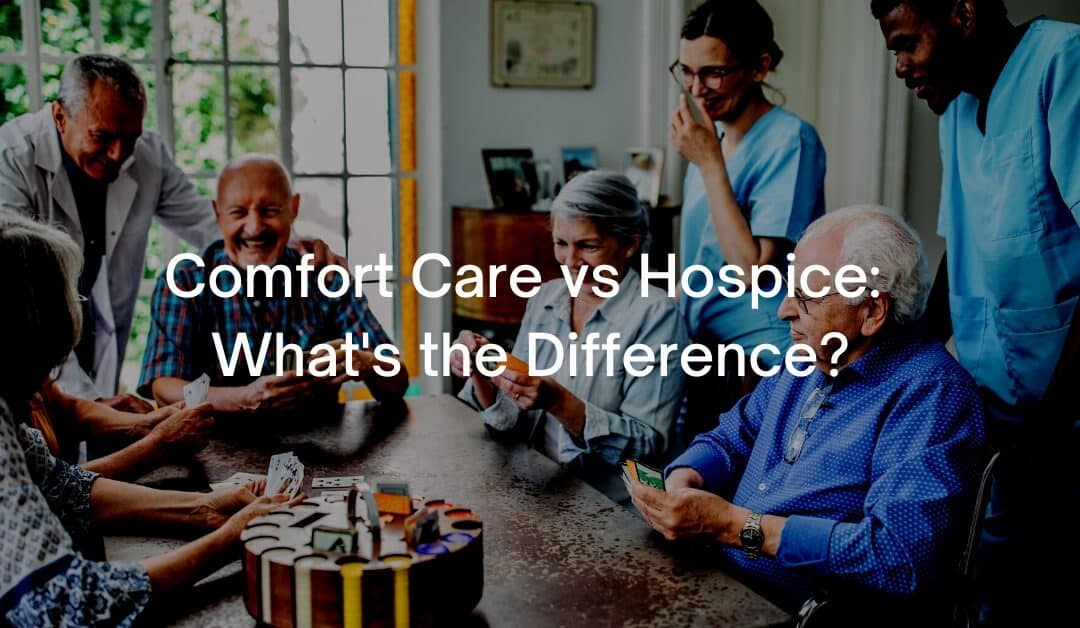What is Comfort Care?
Comfort care is a type of palliative care to manage pain and symptoms toward the end of a person’s life. The goal of comfort care is to improve the quality of life for the patient and help them pass peacefully and without pain. Let’s look at comfort care vs hospice and how you can prepare for a loved one’s death.
Comfort Care Vs Hospice Care
Comfort care is another name for hospice medical care. Hospice care aims to keep patients “comfortable” by managing their pain and symptoms. Another equally important goal is to relieve anxiety and improve quality of life while facing end-of-life.
Hospice is an end of life care for those with a terminal illness. Hospice services exist in hospitals, living facilities, veterans facilities, nursing homes, assisted living facilities, home-like hospice residences, and other facilities.
Facts about hospice care in the United States:
- Hospice helps people who are terminally ill live comfortably.
- Hospice isn’t only for people with cancer.
- The focus is on comfort, not curing an illness.
- A specially trained team of professionals and caregivers provide care for the “whole person,” including physical, social, emotional and spiritual support.
- Services typically include physical medical treatment, counseling, drugs administration, medical equipment, and supplies for terminal illness.
- Home care services are often available
- Family caregivers can get support. (1)
Comfort care is symptom control and physical comfort rather than healthcare with curative intent. Hospice ensures a pain-free passage from this life using pain and anti-nausea medication.
With a life-limiting illness, hospice patients may experience symptom relief and relief from other issues, such as nausea or anxiety. Pain relief is crucial for the patient and family caregivers also. No one wants to see a family member suffer from a life-threatening illness.
Who Provides Hospice Care?
The medicare hospice benefit will cover the hospice program to relieve pain if the prognosis is six months or less. The hospice team typically includes a physician, nurses, home health aides, and a social worker. These professionals have experience caring for dying individuals.
The family can provide additional support, including providing comfort care activities such as companionship, massage, music therapy, and other special comforts to enhance the patient’s quality of life.
How Long Does Comfort Care / Hospice Care Last?
According to a study published in the Journal of Palliative Medicine, roughly half of the patients who enrolled in hospice died within three weeks, while 35.7 percent died within one week. (2) Several factors will determine how long a person will receive treatments.
Medicare will cover hospice benefits if the patient’s prognosis is less than six months. Some patients live longer than six months. In this case, the physician may recertify the hospice care, and Medicare will approve another six months of care.
Hospice and Palliative Care
Hospice care works to help a person who is dying cope with their symptoms. With a life expectancy of less than a year, these patients need serious pain management. Their medical team worries less about whether their treatments may cause problems years later. The concern is managing severe levels of pain now. There is no focus on curative treatments.
While a hospice care team focuses on end-of-life care, palliative care differs. Palliative care is not just for those with a prognosis of six months or less. Many individuals use palliative care to cope with painful symptoms for years on end.
Palliative Care and Curative Treatment of Disease
A palliative care team often includes social workers, spiritual advisors, a doctor and nurse, trained volunteers, and family members. This team offers comfort and support during a serious illness such as heart failure or other chronic diseases.
Unlike hospice care, palliative care teams don’t put a timeline on treatment. The goal is to relieve pain and suffering while helping patients live their best lives.
Patients may use curative care treatments alongside comfort measures to treat their illnesses and manage symptoms. Palliative care patients may live in many environments, including a nursing home, hospital, or their own home.
A palliative care organization supports a patient and their family in diverse ways throughout the life of an illness. Making your end-of-life plans or preparing for a death in the family can mean you need more spiritual care or grief support. Palliative care seeks to cover all aspects of needed care.
Hospice or Palliative Care?
Whether a family member needs hospice or palliative care depends on their condition, prognosis, and goals for treatment. Hospice is best for those in the final stages of life and whose primary goal is comfort care. Those seeking to manage chronic illnesses and symptoms may choose palliative care.
Contact your doctor or another healthcare provider for more information about hospice or palliative care. Understanding the difference between the two types of care can help you decide what type of care is best for you or your family member.
We Can Help
Whether you need to prepare for your own future or that of a family member, we understand how difficult it can be to think about planning a funeral. At Renaissance Funeral Home and Crematory, we want to help. We provide practical advice and resources to make your funeral planning process understandable and manageable.
Contact us today to learn how we can help you plan a beautiful and memorable event for your loved one. Our experienced staff is here for you during these difficult times. Contact us today to get started on your end-of-life plans and rest easy knowing you’ve made the tough decisions.


